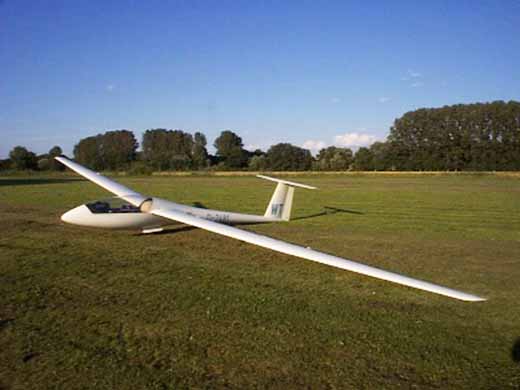
Rolladen-Schneider LS-6
Autre nom (ou nom en langue originelle) : Lemke-Schneider LS-6| DONNÉES GÉNÉRALES |
| Année du premier vol (ou de design, si seul projet) |
1983 |
| Pays | Allemagne |
| Designer(s) | LEMKE, Wolf & SCHNEIDER, Walter |
| Premier constructeur | Rolladen-Schneider Segelflugzeugbau GmbH, D63323 Egelsbach (DE) |
| Type d'appareil | Planeur |
| Fonction | Performance |
| SPÉCIFICATIONS TECHNIQUES |
| Envergure | 15 m |
| Longueur | 6.65 m |
| Hauteur | 1.3 m |
| Allongement | 21.4 |
| Surface alaire | 10.53 m2 |
| Profil aile | AH-FX81 - K 130/17 et FX 81-K 148/17 |
| Masse à vide | 252 kg |
| Masse maxi | 525 kg |
| Charge alaire | 48.9 kg/m2 |
| Vitesse mini | 65 km/h |
| Vitesse maxi | 270 km/h |
| Finesse maxi | 40 à 97 km/h |
| Taux de chute mini | 0.58 m/s à 85 km/h |
| Nb sièges | 1 |
| Ballast | 140 L |
| Structure | -- |
AUTRES INFORMATIONS
| Constructeur(s) |
| ||||||
| Infos techniques | Les volets sont couplés aux ailerons. Aérofreins type Schempp-Hirth sur l'extrados. Empennage en T. Ballast de queue de 5 kg optionnel sur les modèles LS-6A et -6B. Le LS-6 peut être équipé d'extensions d'ailes portant l'envergure à 17,5 m (LS-6c/ 17.5) ou 18,0 m (LS-6c/18.0 m) Variantes : LS-6 Version de production initiale. LS-6A With a new construction for the elevator employing an aramid / corrugated paper sandwich, and a modified ballasting system, namely larger water ballast bags and an optional tank in the vertical fin for center of gravity corrections. LS-6B (1987) introduced a lighter and stronger construction for the wing shells employing a glass, foam and carbon sandwich. A ballast system with independent valves in each wing was offered as an option. The LS-6B and all subsequent versions reverted to the original carbon / aramid elevator. LS-6C major redesign, the most important novelty being the interchangeable wing tips allowing a span extension to 17.5 metres. This longer span required a larger rudder, increasing the overall length by eighteen centimetres. Concurrently, the cockpit was reinforced for increased crash safety and the allowable weight of non-lifting parts was increased. At the same time the control and ballast systems were brought up to a new standard shared with the LS7: fully automatic control hook-ups, a mass-balanced flaperon drive system (previous versions having anti-flutter dampers), airbrake locks relocated in the wings, a trigger-activated trim system in place of the trim wheel, a new ballast system that did away with plumbing inside the fuselage and Mylar seals for all control surfaces. LS-6C-18 reduction in ballast capacity to 100 litres to accommodate the 18 metre wing extensions with winglets and an increase in maximum speed up to 280 km/h. LS-6-18W further convergence with the LS8: winglets for the 15 metre span and stronger spars allowing an increase in ballast capacity to 140 litres. | ||||||
| Histoire résumée | Le planeur de course classe 15 m LS-6 a volé pour la première fois en 1983. Il prit les deux premières places des Championnats du monde 1985 à Rieti (Italie) et les trois premières places des championnats du monde 1987 à Benalla (Australie). En 1991, aux championnats du monde (Uvalde, Texas, USA) les quatre premières places revinrent à des LS-6B et LS-6C. | ||||||
| Liens personnalités | Pas de personnalité associée. |
SOURCES DOCUMENTAIRES
| Liens WEB | Site : Alex Sailplane Directory . Note + photo + specs. (2010-03-21 CL) |
| Livres | LS Segelflugzeuge par BINZ, Wolfgang (2014) [p. 124-139. Texte + 27 photos + plan 3 vues + specs]. Sailplanes 1965-2000 par SIMONS, Martin (2005) [p. 132-134. Texte + photo + plan 3 vues + specs]. |
| Autres sources | Jane's All the World's Aircraft 1988-89 |

Team J2mcL © 2003 -
- Pages optimisées pour Mozilla Firefox

